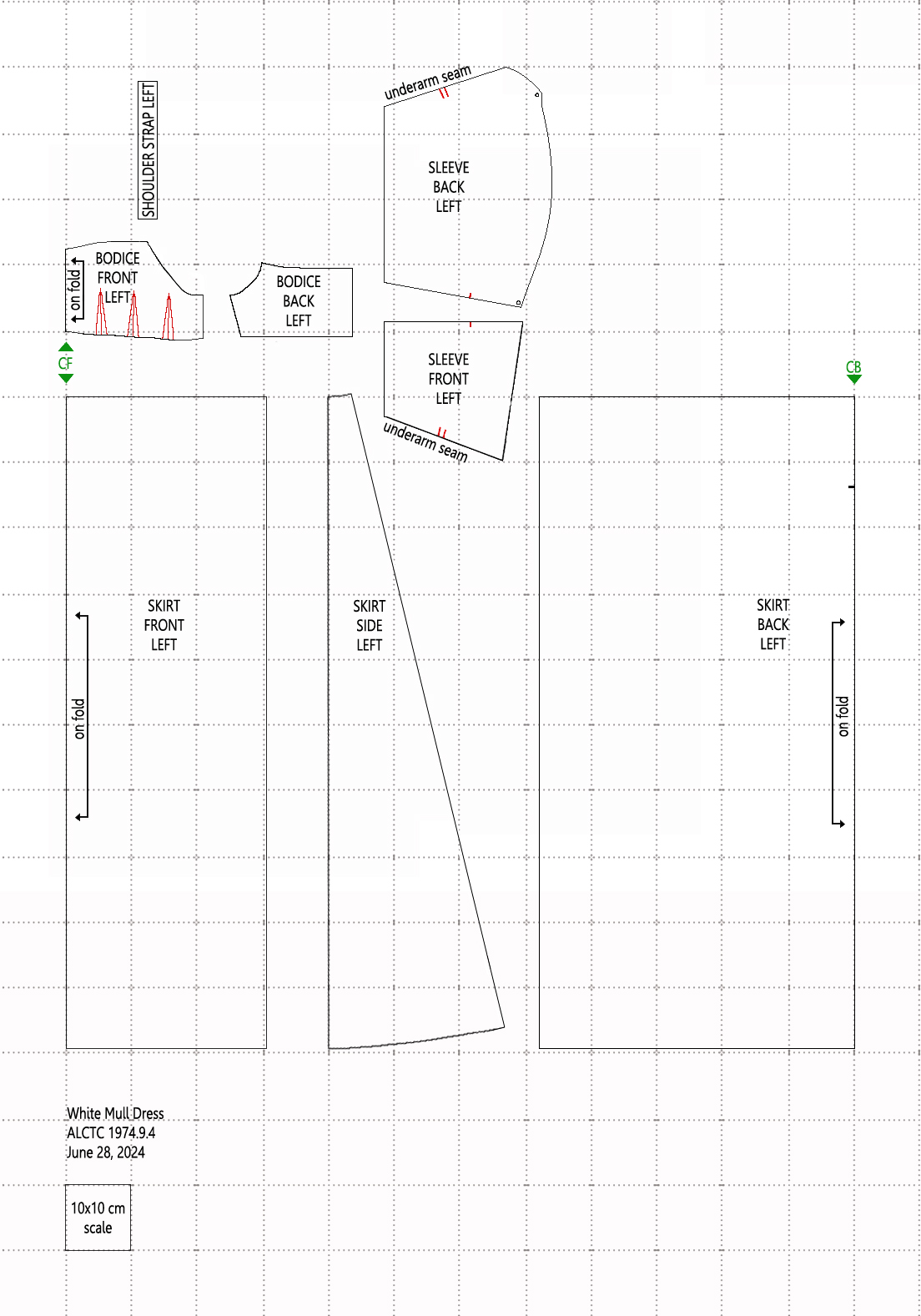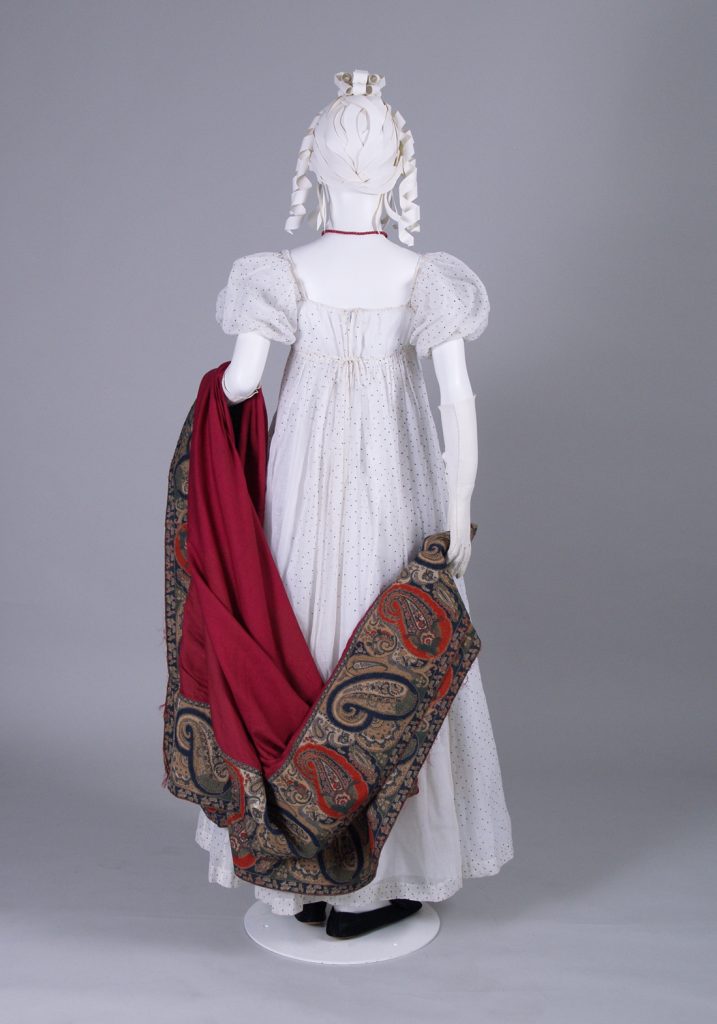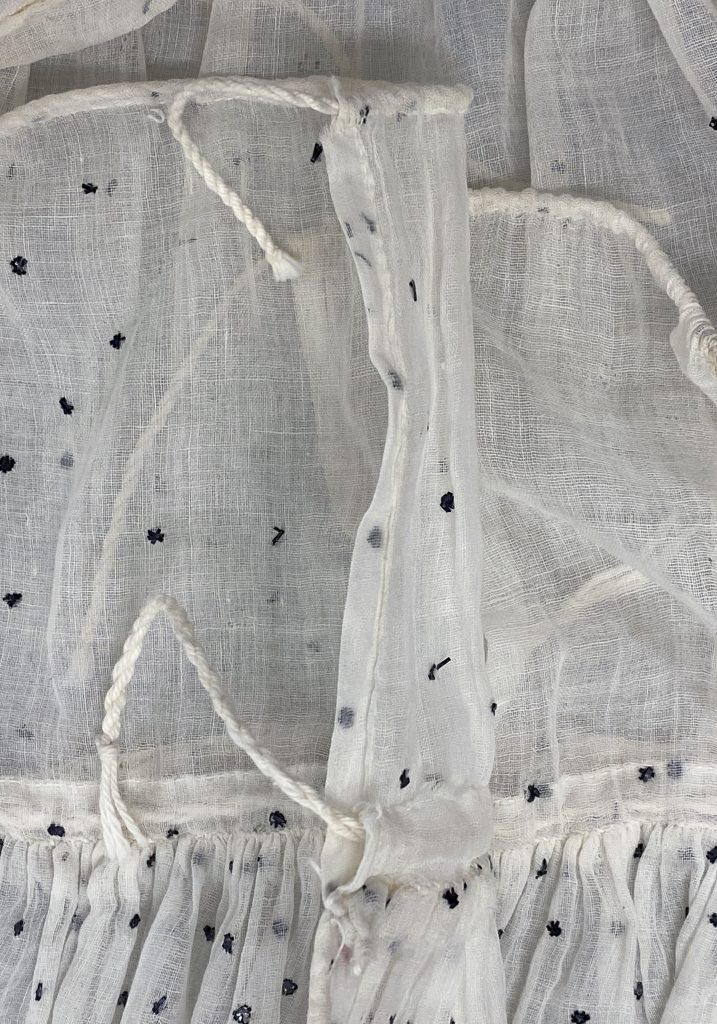
White Mull Round Gown
Unknown creator and place of origin
Mull (i.e. cotton plain weave) with specks of metal silver strips
Date of garment: ca. 1808-1812
Anne Lambert Clothing and Textiles Collection, Department of Human Ecology, University of Alberta
Accession # 1974.9.4
1974 purchase from Cora Ginsburg LLC (Sharon, USA)
University of Alberta School of Household Economics
Artifact adopted by Peggy Isley, March 2013

Figure 1
Pattern Diagram 1974.9.4
 |
 |
| Figure 2 1974.9.4: Front View Paper hair by Sarah Nash, graduate student. Photograph by ©Anne Bissonnette. |
Figure 3 1974.9.4: Side View Paper hair by Sarah Nash, graduate student. Photograph by ©Anne Bissonnette. |
 |
 |
| Figure 4 1974.9.4: Back View Paper hair by Sarah Nash, graduate student. Photograph by ©Anne Bissonnette. |
Figure 5 1974.9.4: Back Detail 1 Paper hair by Sarah Nash, graduate student. Photograph by ©Anne Bissonnette. |
| Worn with:
Square Turnover Shawl with Red Field and Multicolored Decorative Borders Black Satin Slipper Shoes Ivory Kid Gloves Reproduction cotton under dress. |
 |
|
Figure 6 |
 |
|
Figure 7 |
 |
|
Figure 8 |
 |
|
Figure 9 |
*
Observations
This ca. 1808-1812 cotton mull unlined “round” gown (i.e. without the gown opening at the front skirt) has a fitted bodice with a square neckline, an elevated waistline, an A-line silhouette, and short, full sleeves. The sheer, lightweight fabric has small specks of applied metal strips that may have tarnished over time and now look black (Figure 9). While they appear to be all over, some specks are missing in areas where they were likely present and the lower half of the “skirt back” pattern piece has no specks.
The bodice caters to high and wide individual breast volumes. This involves three darts per breast on the “bodice front” pattern piece. The front and back bodice pieces are gathered across the neckline with an enclosed drawstring that ties at centre front (CF) and centre back (CB). The fit at the back bodice is created by an enclosed drawstring at the elevated waistline. This drawstring also serves to close the CB slit opening that starts at the neckline and ends at approximately the natural waist level. The voluminous, two-piece sleeves are gathered at the hem with an enclosed drawstring.
The skirt section is constructed of a narrower rectangular “skirt front” piece, a triangular “skirt side” piece, and a wider rectangular “skirt back” piece. The hem circumference is 234 cm, which accommodates an extremely wide stride.
Of importance:
- The presence of bust darts on the “bodice front” pattern piece indicates this gown was likely worn with undergarments that delineate separate breast volumes.
- This pattern was created early on in our pattern-taking project, therefore it was not done using the streamlined method referenced previously. As such, this pattern and the accompanying construction notes lack some details.
Pattern Notes:
- All descriptions use proper left and right, unless otherwise specified.
- All patterns are placed on the grid, which corresponds to the grain line.
- Seam allowances are not included, including allowances for drawstring channels.
- The “bodice front,” “skirt front,” and “skirt back” patterns pieces are presented on a fold and are thus half their size. The remaining pattern pieces are presented for one side of the body (e.g. the sleeve pieces are for the left sleeve only) except for the “shoulder strap” piece that requires a horizontal fold (along its long axis).
To download a PDF version of this information, click here.
Last revised June 28, 2024
This garment has also been part of the virtual exhibition The Re-Birth of Venus: Fashion & the Venus Kallipygos (2014).
ALCTC Pattern Project team members
Principal Investigator
Anne Bissonnette, PhD
Curator, Anne Lambert Clothing & Textiles Collection
Professor, Material Culture and Curatorship
Co-Principal Investigator
Katelin Karbonik, MA
Associate Curator, Anne Lambert Clothing & Textiles Collection, October 2022-March 2024
CAD Design
Siming Guo, PhD
Graduate Research Assistant, May-August 2022
This research was funded by the Government of Canada’s Reopening Fund for Heritage Organizations – Museums Assistance Program, and the Social Sciences and Humanities Research Council.

Virtual Exhibition
